- Home
- Get into Painting
How to Get into Painting Art: Realizing Your Dreams
Are you wondering how to get into painting?
Millions of people are painting and you can learn how to paint, too!
Painting art is a universal language that uses our senses, emotions and mind to create something beautiful.
Anyone can start painting regardless of your age or experience.
If you’re thinking about getting into painting, this page will help you choose a medium, start on a budget, and decide what to paint.
If you’re ready for a step-by-step beginner path with fundamentals and quick-start projects, visit Learn to Paint – Beginner’s Guide to start painting.
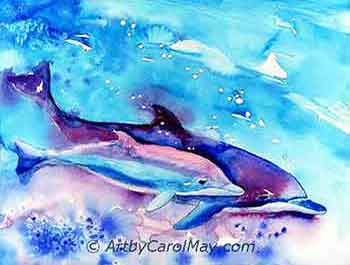 You can learn how to paint!
You can learn how to paint!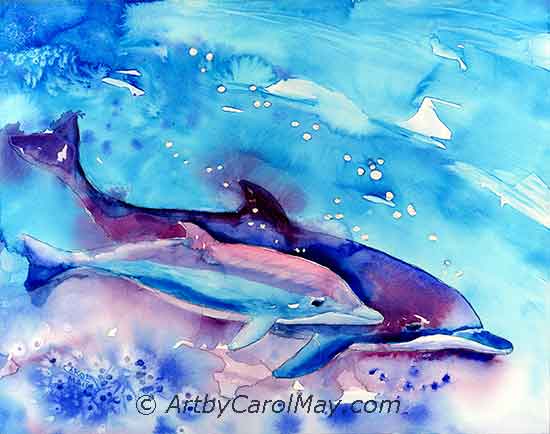 You can learn how to paint!
You can learn how to paint!How to Get into Painting
This is your introduction to the essential tools, the best paint, what to paint, how to avoid mistakes and tutorials to start painting.
Whether you’re a complete novice or looking to refine your skills, get ready to paint.
What Paint is Best for Beginners?
Here in the United States the three popular art paints are oil paint, watercolor and acrylic. Each medium has its own characteristics and requires a slightly different approach.
When you have a good teacher, you can learn to paint with any medium.
One type of paint is not better than the others. It just a matter of personal preference.
Oil Paint is Easy to Use
The classic paintings of the old masters were oil. When oil paintings are well cared for, they can last for centuries.
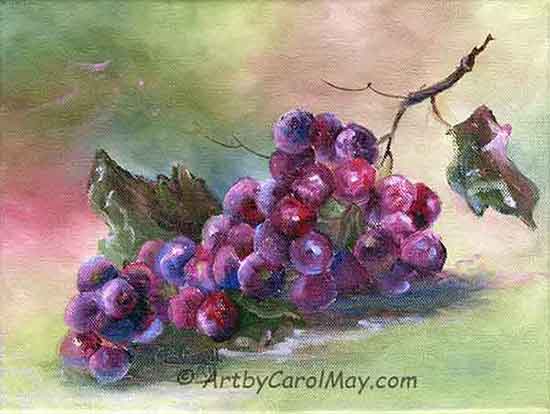 Oils may be painted smooth or textured.
Oils may be painted smooth or textured.Oils are quite easy to use.
Myself and my family learned how to get into painting using oil paint.
Oils are slow drying.
They may be reworked until they are dry. If you don't like something, you can scrape it off and repaint it. You may also, paint over a dried oil painting months later.
What supplies do you need?
You may start oil painting with a couple of brushes, Gamsol odorless mineral spirits and a canvas.
Stretched canvas is best for oil painting, but canvas boards are good for learning. Oil paintings are easy to frame and long lasting.
Alkyd: The Modern 'Oil Paint'
The color pigments in alkyds are mixed
with an alkyd resin, instead of oil. That speeds up the drying time to within 24 hours.
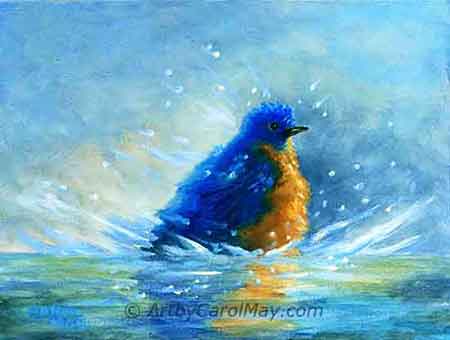 I enjoy painting details with alkyds.
I enjoy painting details with alkyds.During the 1980s my mother and I were attending a workshop where the instructor introduced us to alkyds.
We tried it so our paintings would be dry for the trip home. I have been using it ever since.
There is plenty of time for blending. But they dry fast enough to paint layers in a short amount of time.
I find their fast dry time makes it easier to paint the finer details.
All the 'oil paintings' on this website are actually alkyd paint. Finished alkyd paintings look exactly like an oil painting.
Alkyd uses the same brushes, solvents, supports and painting techniques as oil.
Watercolor Is Another Easy Paint
It's a light, delicate medium that's great for capturing the subtleties of light and color. As the name implies, it thins and cleans up with water.
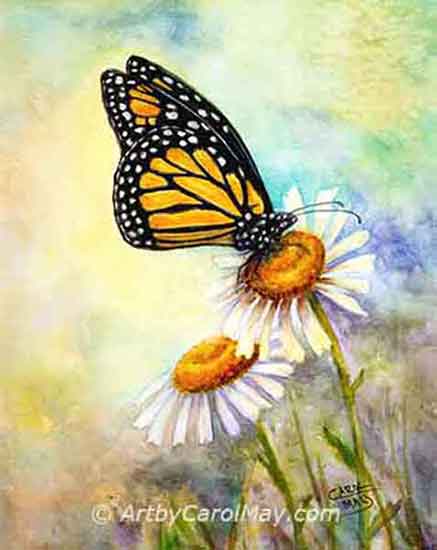 Watercolor butterfly art
Watercolor butterfly artWatercolors are somewhat unpredictable in the way they move and blend with other colors.
The key is learning how much water to use. That's the joy of watercolor.
Watercolor paint comes in two forms.
We may get moist watercolor paint in tubes.
It comes in dried cubes, called pans. They are portable and favored for painting on location.
We have a choice of 3 supports.
Watercolor paintings are traditionally painted on paper. Watercolors on paper require a mat and they are framed under glass for protection.
Today watercolors may be painted on Aquabord or watercolor canvas. The paint is easier to remove from Aquabord or watercolor canvas.
Dry watercolor paintings on Aquabord or canvas can be sprayed with a fixative. Then the painting is framed without a mat or glass.
You can get into watercolor with paint, water, paper and one or two bushes.
Acrylics Are Versatile
Acrylic provides the ability to paint in thin washes like watercolor or thick like oil paint. It thins and cleans-up with water.
Acrylics are widely available, and considered a good way for the beginner to get into painting. It dries very fast and that makes it hard to blend the colors.
They normally are painted on canvas, but they may be painted on various surfaces like rocks or wood. I painted fruit and flowers on my kitchen cabinet doors and then varnished over the finished paintings for protection.
The colors are bright and durable. They dry to a flat finish, so the finished paintings are often varnished. Acrylic paintings are simple to frame.
Regardless of the medium you choose, learning how to paint requires practice and patience. Let your art journey be guided by your love of the process and not just the end result.
You may want to explore other painting mediums.
Can We Begin Painting on a Budget?
How can we get into painting without spending a bundle? We can spend a lot of money at the art store, but what do we really need?
Basically, we need: paint, brushes, a palette, something to paint on and clean-up materials.
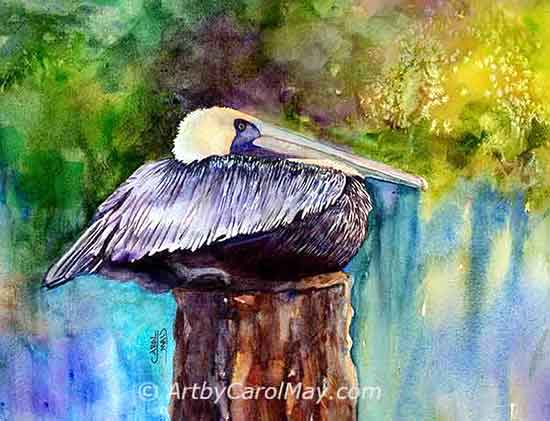 Begin painting with just a few items.
Begin painting with just a few items.What Colors Do We Need? Start with the 3 primary colors. Other colors are easy to mix from these three primaries.
- Cadmium Light Yellow
- Cadmium Red Light
- Ultramarine Blue
Oil, alkyd and acrylic artists also need a tube of white and a palette knife for mixing the colors.
What Brushes Do We Use? Start with just a couple of brushes to get the feel of painting.
- Oil and alkyd - #8 and #12 flat hog hair or synthetic oil brushes
- Watercolor - #7 or #8 round and 1" flat, 'labeled for watercolor'
- Acrylic - #6 round and 3/4" flat synthetic brushes, because natural hairs retain water
Do We Need a Palette? Yes, we need a place to mix paint.
Oil, alkyd and acrylic can use a Styrofoam plate and dispose of it after painting. Watercolor may use an old kitchen plate and wash it after painting.
What Do We Paint On?
- Oil, alkyds and acrylics are painted on canvas.
- Watercolor can be painted on 140# watercolor paper.
Clean-up Materials: Everyone uses paper towels or rags.
Oils and alkyds use a covered container of Gamsol odorless mineral spirits. Watercolor and acrylic use a container of water.
Once you have the basics supplies, you’re ready to check out the Beginner’s Guide and start your first paintings.
Keep this list of items in stock, so you'll be ready to paint at any time.
The most expensive products are not always necessary. The best approach is to stick to the basics and then slowly build your collection as you progress.
Later you may add other colors for an extended palette.
Should We Use Student Paint?
When we are learning "student paint" is enticing because it costs less.
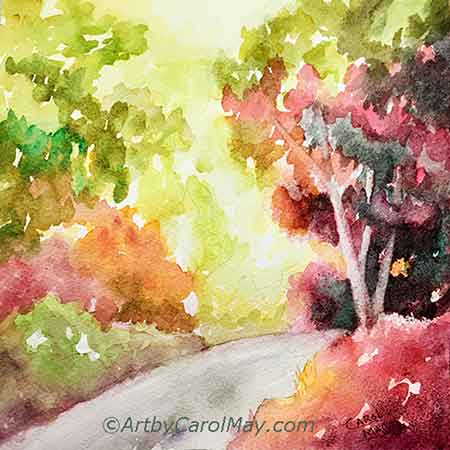 What's the best paint to buy?
What's the best paint to buy?All paints are made with color pigments mixed with other ingredients.
Is student paint a better buy?
We have to use more student paint to get the vibrant colors of artist paints.
Why? Because student paint contains less color pigment and more other ingredients.
For me, one of the great joys of painting is color, so I always enjoy using artists paints.
If you do opt for student paints, Winsor Newton student paints, called "Cotman" paint is good. They contain a high amount of color pigments.
What Should We Paint?
Now comes the fun part of getting into painting - deciding what to paint!
The best place to begin painting is the things around us.
We do the best job of painting things we know. We have a better idea of their form and colors.
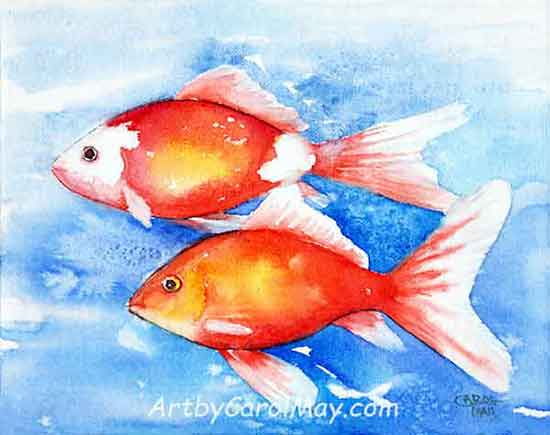 Paint things familiar to you.
Paint things familiar to you.When I was giving my sister a painting lesson, we painted her two goldfish "Speedy and Tuna".
We used a simple palette of red, yellow and blue.
First, we painted the fish. Then we painted the background around the fish.
We sprinkled salt into the wet background paint to add texture.
Paintings are personal. They are like a part of ourselves.
Painting is lots of fun and the joy we find in painting will inevitably reflect in our artwork.
What Makes It Easier to Learn Painting?
Start painting simple subjects.
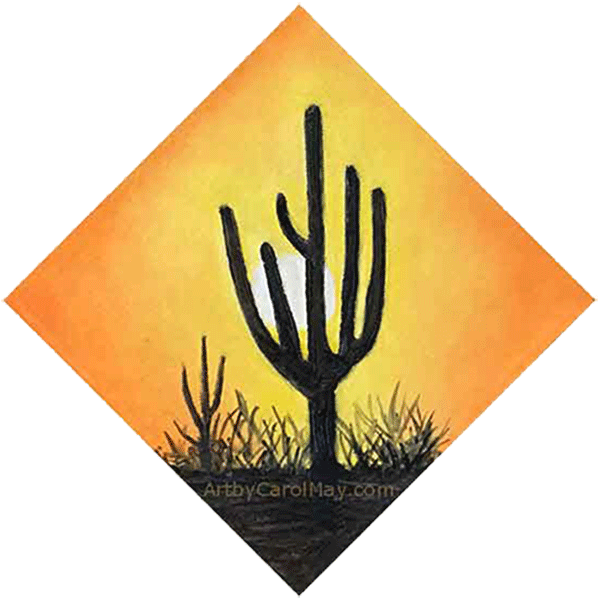 Start with small paintings.
Start with small paintings.Begin painting small and easy.
A piece of fruit, a cup of coffee or a simple landscape scene would make a good start.
Small paintings, like a 5x8, 6x6, or sometimes an 8x10 inch can be done in an hour or two.
Finishing a painting in one session is encouraging. It makes you want to do another one.
As you progress and build confidence, then start painting larger and more complex subjects.
That's the beauty of learning how to paint.
Do We Begin Painting From Life or Photos?
When we actually see the subject, we can do a better job of painting it.
Many artists enjoy painting from life. You may not have goldfish to paint and the birds and bees don't stay still long enough for us to paint them. So, what do we do?
We may also paint from photos. Paint from our own photos or copyright free images.
Look for public domain images or creative commons images have no copyrights attached. Pixabay.com is a good place to find public domain and CCO images.
Inspiration can come from anywhere. Keep a tablet to jot down ideas and sketch things to paint.
How Do We Avoid Beginner Mistakes?
Paintings are built upon the basic fundamentals of color, composition and values.
These basics serve as the building blocks of our artistic expression. Get a good grasp of them and you'll be well on the road to successful artwork.
What Is a Common Beginner Mistake?
Values - the lightness or darkness of colors - are one of the biggest keys to painting good art.
A very common beginner mistake is simply ignoring values.
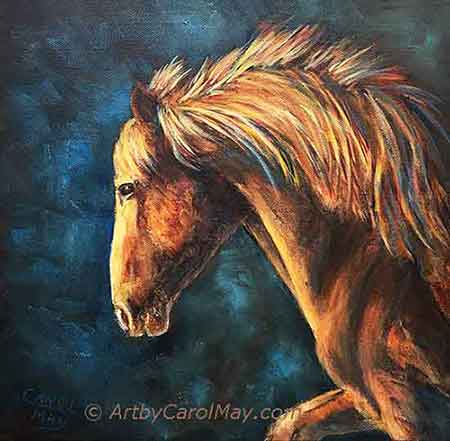 Values make impactful artwork.
Values make impactful artwork.When all the colors in a painting are close to the same value, the picture looks flat and dull, no matter how pretty the colors are.
When you use a range of light, medium, and dark values, your paintings become more interesting and impactful.
We use values to:
- Direct the viewer’s focus
- Suggest depth and distance
- Make objects look three-dimensional
- Place one object in front of another
As you get into painting, begin training your eye to notice light and dark, not just colors. Learn to see and use values in your paintings.
How Do We Mix and Use Colors?
Have you ever marveled at the vibrancy and harmony of colors in a beautiful painting? Using color is one of the real joys of painting.
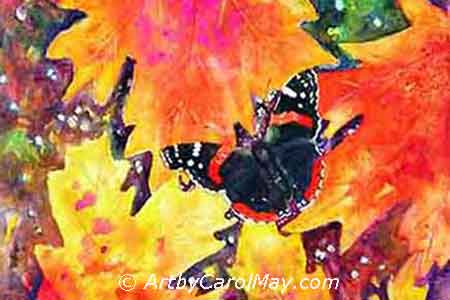 Color is fun!
Color is fun!Color is a vital concept for every artist.
A simple color wheel can be very helpful when we first begin painting. It helps us identify colors and choose pleasing color combinations.
It also helps to notice color temperature:
- Warm, bright colors like reds and yellows tend to come forward.
- Cool colors like blues, greens, and purples tend to recede.
Color is a powerful tool in the hands of an artist. As you start to understand how colors work together, they become one of your most precious tools.
How Do We Make Good Paintings?
Composition provides the framework of our artwork.
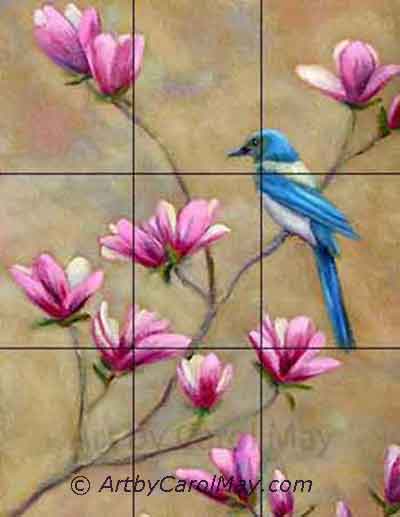 Composition is easy.
Composition is easy.It's how the elements are arranged in the painting.
A good composition creates pleasing paintings.
A well-composed painting is balanced, and each element harmonizes with the rest.
The composition draws the viewers in and guides them throughout the painting.
The rule of thirds makes composition easy. It's a no-brainer when we are learning how to paint.
It always creates a good composition, so we can concentrate fully on the process of painting.
We divide the painting surface into nine equal portions. Place the main elements of the painting along these lines or their intersections.
This automatically creates energy and interest in our paintings.
There are many more helpful tips for creating strong compositions.
Do I Need to Know How to Draw?
Some people are naturals at drawing. Others like me, learn drawing as they paint.
You do NOT have to be “good at drawing” to get into painting. Just start painting. Painting familiarizes you with the shape and proportion of things and that improves your drawing skills over time.
The beginning tutorials provide an easy way to get into painting without fine drawing skills.
So don’t let drawing hold you back. Start painting, and let your drawing develop along the way.
For more tips on learning to paint even if you can’t draw, see the “Can I learn to paint if I can’t draw?” section in my Learn How to Paint Art guide
Should We Start with the Fundamentals First?
It's not necessary to learn all the fundamentals of art, like values, how to mix colors or creating a composition before you begin painting.
Start painting and get the feel of your paint and brushes.
You'll pick up these basic fundamentals along the way while you are painting.
How did I used the elements and principles of art in an award-winning painting?
What's the Best Way to Begin Painting?
The best way to get into painting is by actually painting.
The tutorials are your tools to begin painting and learn at the same time.
Each tutorial contains the details of how to do the painting step-by-step.
Choose the tutorials that pique your interest and start painting. You get to paint and learn at the same time.
Check out the guide to the painting tutorials.
Do You Want to Start Oil Painting?
Oil painting is easy. Painting with any medium is easy with a good teacher.
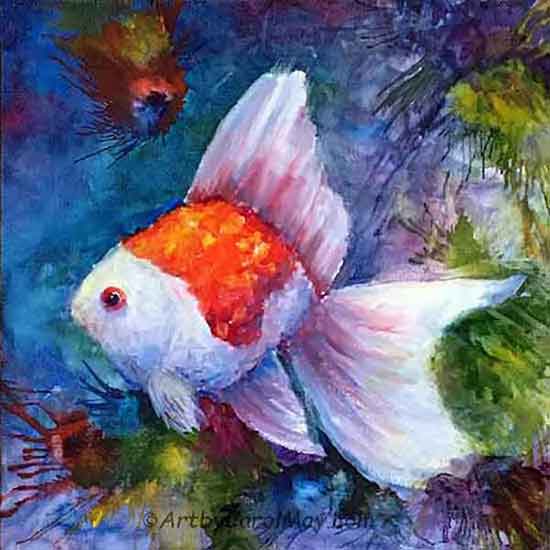 A "Fun Fish" oil painting tutorial
A "Fun Fish" oil painting tutorialMost of my paintings are done with a limited palette.
A limited palette consists of only one to five colors. Any additional colors are mixed.
This oil painting tutorial of a "Fun Fish" is done with a limited palette of yellow, red and blue.
The bluish background is painted around the fish. Then we paint the fish.
Then thinned paint colors are blown through a soda straw onto
the blue background to simulate seaweed. That makes this a "fun" painting.
You Can Learn How to Paint Watercolor
Many people get into painting with watercolor.
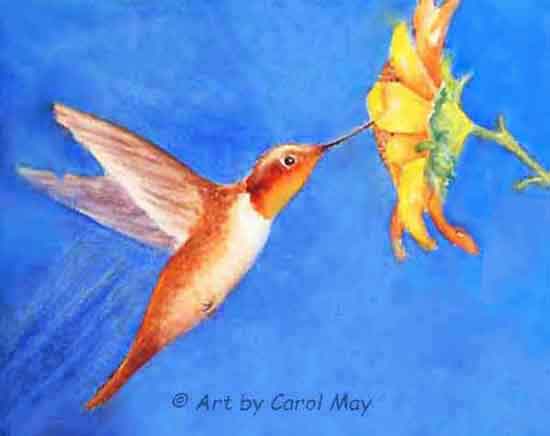 Paint a watercolor hummingbird.
Paint a watercolor hummingbird.You can start painting watercolor with this hummingbird tutorial.
Get important tips on:
- The #1 rule of painting watercolor.
- Painting wet into wet.
- Painting wet into dry areas.
- How to gradate the colors.
- A tip on correcting mistakes.
Then you can use the same steps and tips to do a watercolor painting of any subject.
Frequently Asked Questions
Here's some questions you may have been wondering about.
What is The Best Place to Paint?
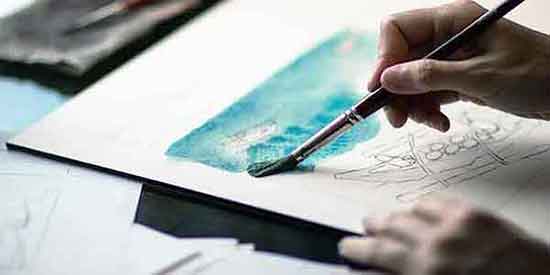 What's a good place for painting art?
What's a good place for painting art?If we have a place to leave our painting stuff out ready to go, we are more likely to paint.
How do we store our supplies?
I started out storing my paint and
brushes in a fishing tackle box. Different things work for different
people.
What about lighting and ventilation in your painting area?
What is the best type of light bulbs for painting art?
How Many Colors Do We Need to Learn Painting?
How Many Colors Do We Need to Learn Painting?
We can create stunning paintings with the primary colors yellow, red and blue.
Anything from landscapes to portraits can be painted with 3 colors.
Take a look and see how to paint a child's portrait with three colors.
What Happens When We Run Out of Umph?
What Happens When We Run Out of Umph?
Painting is fun, but sometimes we just can't get into painting.
This happens to all artists from time to time. That's called an artist's block.
We can get our creative juices flowing and back to painting again with new inspiration.
What's the Best Way to Stay Inspired?
What's the Best Way to Stay Inspired?
Show your work to friends, family, and other artists, and consider joining a local art association or small painting group.
Visiting art classes, shows, and museums will also give you fresh ideas and energy.
For more ideas on building a regular painting habit and developing your own style, see How to Stay Inspired and Find Your Style.
What's the Fastest Way to Learn Painting?
What's the Fastest Way to Learn Painting?
Painting on a regular basis puts learning to paint into overdrive!
The more we paint, the faster we learn.
Include painting in your schedule. No matter whether you paint daily, weekly or monthly - paint regularly.
There's a special joy that comes with a completed a painting.
It gives us a sense of accomplishment. Plus, it's fun to have something to share with our friends and family.
What Did That Artist Say?
What Did That Artist Say?
There are common art terms used by today's painting artists.
Sometimes, we may not understand what an artist is talking about.
Check out the glossary of art terms, it includes:
- General Terms, including color terms
- Art Supplies - the types of paint, what we paint on, brushes etc.
- Painting Techniques for both oil and watercolor
Painting Is a Joy!
It's fun learning something new. And who doesn't like a challenge?
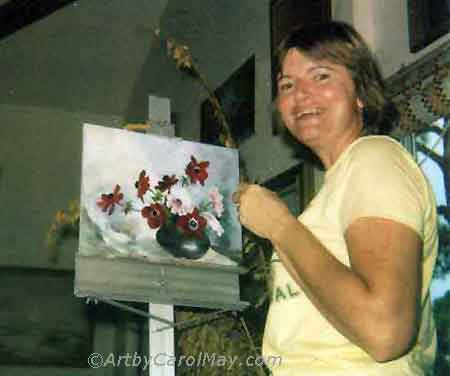 The many joys of painting art.
The many joys of painting art.Get involved, that's how to get into painting.
When I was learning to paint, my full concentration would be on painting.
One time, everything else slipped my mind, like cooking dinner. Late in the afternoon my husband asked, "Are we having dinner tonight?"
Oh my, I was so engrossed in painting that I completely forgot about the time, dinner and my hungry husband.
So, the painting had to stop and get finished after dinner and dishes.
Review How to Get into Painting
You’ve taken the first steps to start painting. You are equipped with essential tips on selecting the right supplies, what to paint, staying inspired and avoiding common pitfalls.
When we begin painting, we start to see the world with a fresh, new light.
- Choose your medium.
- Get your budget supplies.
- Select a subject.
- Start painting, we learn the most by actually painting.
- Get involved, painting and sharing with others is fun.
The real joy of painting is in expressing ourselves and enjoying the process!
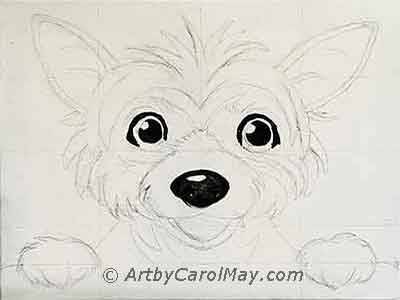
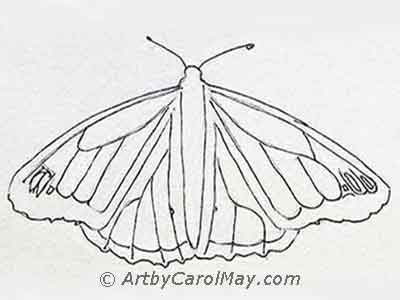






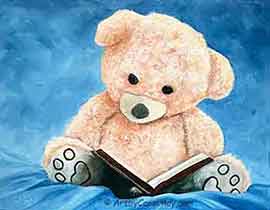 Are you eager to learn how to oil paint? What are the essential supplies for oil painting? What do we need for clean-up and how long do oil paintings take to dry? Learn the rules of oil painting and t…
Are you eager to learn how to oil paint? What are the essential supplies for oil painting? What do we need for clean-up and how long do oil paintings take to dry? Learn the rules of oil painting and t…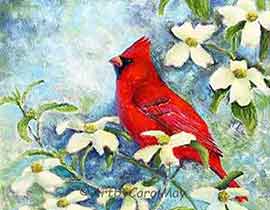 How do we create a focal point in art? Where do we put the focal point? How do we find the focus of an artwork? Should all paintings have a center of interest or can they have more than one? Learn fro…
How do we create a focal point in art? Where do we put the focal point? How do we find the focus of an artwork? Should all paintings have a center of interest or can they have more than one? Learn fro…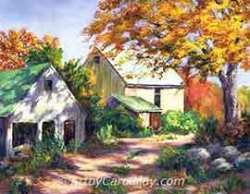 Art elements and principles appear over and over in good paintings. The elements and principles work together for us to create successful artwork. Art principles are the rules that govern how an artis…
Art elements and principles appear over and over in good paintings. The elements and principles work together for us to create successful artwork. Art principles are the rules that govern how an artis…